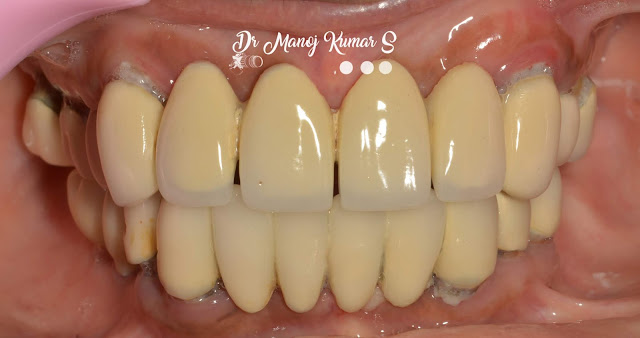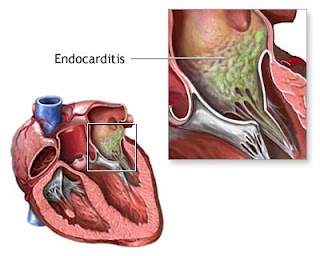MYOFACIAL PAIN DYSFUNCTION SYNDROME



MYOFACIAL PAIN DYSFUNCTION SYNDROME
Temporomandibular joint disorders are among the most misdiagnosed and mistreated disorders in medicine. Though, a lot of research is constantly being carried out, TMJ problems raise many question, some of which remain unanswered or debatable, because of the complex nature of this joint.
MPDS is a pain disorder, in which unilateral pain is referred from the trigger points in myofacial structures, to the muscles of the head and neck. Pain is constant, dull in nature, in contrast to the sudden sharp, shooting, intermittent pain of neuralgias (chronic pain).But the pain may range from mild to intolerable.
SYMPTOMS
MPDS exhibits varied symptoms. One particular patient may complain of all the various symptoms, whereas in another patient only a single symptom may be present.
THE MOST COMMON SYMPTOMS ARE:
• Headaches
• Earaches
• Tenderness in the jaws
• Dry mouth
• Fatigue
• clicking or popping sound in the jaws
• Neck or shoulder pain
• Dizziness and lightheadedness
• Diminished hearing
• Ringing in the ears
• Fullness in the sinuses
• Limited jaw movement
• Pain in the eyes or the back of the eyes
• Tingling
• Numbness
• Blurred vision
• Twitches
• Trembling
• Nausea
• Vomiting
• Diarrhoea
• Constipation
• Indigestion
TRIGGER POINTS
Trigger points exists as a localized tender areas within taut bands of skeletal muscles and when stimulated by macro and micro traumatic episodes, they refer a characteristic pain pattern to a distant group of muscles, i.e. zone of reference.
Palpation of trigger points will give rise to a positive ‘jump sign’.
Factors which can cause trigger points:
• Sudden trauma to musculoskeletal tissues (muscles, ligaments, tendons, bursa)
• Excessive exercise
• Chilling of areas of the body
(e.g., sitting under an air conditioning duct; sleeping in front of an air conditioner)
• Injury to intervertebral discs
• Systemic conditions
(e.g., gall bladder inflammation, heart attack, appendicitis, stomach irritation)
• Lack of activity (e.g., a broken arm in a sling)
• Muscle strain due to over activity
• Generalize fatigue (perhaps, chronic fatigue syndrome may produce trigger points)
• Nutritional deficiencies
• Hormonal changes (e.g., trigger point development during menopause)
• Nervous tension or stress
• Obesity
• Depression
• Anxiety
• Poor posture
• Repetitive motion
• Hypoglycemia
• Menopause
PATHOPHYSIOLOGY [ETIOLOGY] :
The MPDS can be visualized as a vicious cycle of several contributing factors such as:
1. Muscular hyperfunction.
2. Injuries to the tissue.
3. Faulty alignment between the upper and lower teeth and jaws
4. Disturbed movement of the jaw joint
5. Displacement or abnormal position of the jaw joint or cartilage disc inside the jaw joint
6. Arthritis or similar inflammatory process in the joint
7. Para functional habits.
8. Disuse.
9. Nutritional problems.
10. Physiological stress.
11. Sleep disturbances.
TREATMENT:
Medical Care:
• Medications: Commonly used medications include NSAIDs, muscle relaxants, and tricyclic antidepressants. More recently, injections of botulinum toxin have been used, in some cases as an adjunct to arthrocentesis
o Ibuprofen and naproxen are commonly used NSAIDs. They work best when given on a regular basis and are not associated with addiction problems. NSAIDs should be prescribed on a regular basis for a period of 2-4 weeks and then gradually tapered. Narcotics are reserved for patients with severe acute pain and should not be used for more than 10-14 days.
o The commonly used muscle relaxants are diazepam, methocarbamol, and cyclobenzaprine; the lowest effective dose should be used initially. Adverse effects include sedation, depression, and addiction.
o Tricyclic antidepressants, in low doses, have been used effectively for a long time in chronic painful conditions. They act by inhibiting pain transmission and also may reduce nighttime bruxism. Amitriptyline and nortriptyline, in small doses, are the most common tricyclic antidepressants used for chronic painful conditions.
o Botulinum toxin is used both as a single treatment and in conjunction with arthrocentesis. No controlled studies exist of the use of this medication in TMD. Care must be taken to isolate the muscle properly and inject appropriate doses.
Aspirin- 0.3-0.6g/4 hourly
Piroxicam- 10-20mg/TDS
Ibuprofen- 200-600mg/TDS
Pentazocine-50mg/BD or TDS
Diazepam- 5-10mg/BD or TDS
Methocarbamol-500mg/BD or TDS
Amitriptyline- 10-25mg/TDS
• Occlusal splints To temporarily disengage teeth
To create a balanced joint-tooth stabilization of mandible
To reduce hyperactivity of musculature
To improve vertical dimension
To serve as a protective appliance
o Stabilization splints:
12 to 18 hours wear for upto 4-6 months.
Fabricated over maxillary teeth covering occlusal and incisal surfaces.
Reduces the load on retrodiscal area and thereby relieves pain.
o Relaxation splints:
For disengagement of teeth and only for short period (4 weeks).
Fabricated over maxillary incisor teeth.
o There are different kinds of splints known as night guards, bruxism appliances, or orthotics. Various kinds of splints are available; most of them can be classified into 2 groups—anterior repositioning splints and autorepositional splints. Physiologic basis of the pain relief provided by splints is not well understood. Factors such as alteration of occlusal relationships, redistribution of occlusal forces of bite, and alteration of structural relationship and forces in the TMJ seem to play some role.
o Autorepositional splints, also known as muscle splints, are used most frequently. Some sort of pain relief is seen in as many as 70-90% of patients using splints. In acute cases, the splint may be worn 24 hours a day for several months, later, as the condition permits; they may be worn at nighttime only.
Surgical Care:
The treatment of chronic TMD is difficult, and at some time during the course of the disease surgical options are discussed with the patient. Some of the surgical options are described here.
• Arthrocentesis
o Simple washing of the upper compartment of TMJ using arthrocentesis has been very effective in patients with a history of condylomeniscal incoordination; results have been comparable to those of arthroscopic surgery.
o The benefit of this treatment brings into question the significance of disk position in the etiology of TMD.
o A 22-gauge needle is inserted gently in the superior joint space and a small amount of saline is injected to distend the joint space, after which the fluid is withdrawn and evaluated. The joint then is redistended and a second needle is placed in the same joint space to lavage the joint; steroids and/or local anesthetics can be injected into the joint space at the conclusion of the procedure.
• Arthroscopic surgery
Indications include internal derangements, adhesions, fibrosis, etc.It appears to be as efficient as open surgery, causes less surgical morbidity, and has few severe complications as compared to open surgical procedure. One retrospective short-term study found it to be safe, minimally invasive, and an effective treatment method, with 80% of patients reporting reduced pain and increased range of motion; in acute TMJ lock, however, arthroscopy and arthroscopic lysis and lavage of the upper compartment of TMJ produce comparable success rates.
o In one study, only 10.3% of 301 patients who underwent arthroscopic lysis and lavage had complications. More than 80% of complications were otological in nature; neurological complications were seen in 5 cases—of which 3 were fifth cranial nerves injury and 2 were seventh cranial nerve injury.
• Open surgery
o Open surgery was the main surgical option in the 1970s and 1980s, and the most common procedure was disk repositioning and complication; in cases of severe disk damage, procedures such as disk repair and removal were done using artificial or autogenous material.
o Myrhaug technique: Described in 1951, this procedure, by resecting the temporal condyle, creates a permanent and reducible chronic dislocation of the joint. One study found 70% good or excellent results in 60 patients. The main indications include (1) TMD not responding to all other treatments and (2) chronic subdislocations of one or both TMJ.
• Arthroplasty: This is the surgical procedure of choice for bony intracapsular ankylosis.
• Physical therapy: Apart from patient education and pain control, the main goal of physical therapy is to stabilize the joint and restore its mobility, strength, endurance, and function. Common modalities used to accomplish these goals are the following:
o Relaxation training using electromyographic (EMG) biofeedback: The patient first is educated about the contribution of stress and muscular hyperactivity to pain. An EMG monitor provides instant feedback to patients about the state of their muscle activity and allows the patient to easily correlate pain with hyperactivity of the muscles and decrease in pain with relaxation.
o Friction massage: The hypothesis is that temporary ischemia and resultant hyperemia, produced by firm cutaneous pressure during massage, helps inactivate trigger points. Friction massage also may help disrupt small fibrous adhesions in the muscle formed as a result of surgery, injury, or prolonged restricted motion.
o Ultrasonic treatment: ultrasonic waves produce tissue heating at a deeper level than moist heat; this increase in local tissue temperature leads to increase in blood flow and removal of metabolic byproducts responsible for pain and may help decrease adhesions by disrupting collagen cross-linkage. It also may help decrease intra-articular inflammation. To be effective, ultrasonic treatment should be done every other day, using about 1 watt/cm2 for approximately 10 minutes over the affected muscles and joints.
o Transcutaneous electronic nerve stimulation: Electronic stimulation of superficial nerve fiber overrides the pain input from mastication muscles and TMJ, causing release of endogenous endorphins. In some patients it provides longer duration of pain relief than the time during which the stimulation is actually applied.
• Cognitive-behavioral treatment: This consists of hypnosis, cognitive coping skills, and relaxation. Hypnotic susceptibility correlates with reductions in reported pain.
• Psychology: Chronic painful conditions worsen any preexisting anxiety or depression. In appropriate settings, psychological counseling may provide benefit.



Comments